Sharmans Cross Senior School was built in 1933 and opened to pupils on 9th January 1934 under headmaster Edgar James Phillipps Orrett (1882-1967). Children aged over 11 from Solihull, Olton and Shirley were transferred from existing all-age elementary schools on this date, with the schools they left then all becoming junior schools.
The population of the Solihull district had increased by some 45 per cent between 1921 and 1931 so there was increasing pressure on school places in the Shirley district, where much new housing had been built. The Evening Dispatch, 1st September 1932, reported that at times almost 100 children had had to wait for admission to school, most especially to the infants’ department.
The problem was apparently a lack of school places for older children, which resulted in these children having to remain at the elementary schools, meaning that there was serious overcrowding at the schools.
To ease the situation, Birmingham City Council expressed its willingness to accommodate 50 children over the age of 11 years for the next year or two at the Pitmaston Road school, which is just over the city boundary on the Shirley side.
Sharmans Cross Secondary School was built on farm land on the edge of a new housing development between the Stratford Road and Stanway Road. At the time, no housing existed in Prospect or Danford Lanes, which were just narrow country lanes. There were a few houses in Sharmans Cross Road, and a farm opposite the school in Solihull Road.
It was planned to provide accommodation for 520 pupils at first, with expansion plans for 720 children. Admissions came from all of the surrounding primary schools:
- Solihull C. of E. School
- Sharmans Cross Junior School
- Haslucks Green Junior School
- Bentley Heath C. of E. School
- Tidbury Green Junior School
- Shirley C. of E. School
- Hall Green Junior School
With such a wide catchment area, there were problems with children getting to school. Buses were provided for 165 of the 370 children who attended the school in its first week. 112 children started cycling to school, although the cycle sheds could only accommodate 80 bicycles and so a number of new cycle sheds were subsequently built.
The local authority issued bicycles to pupils who lived more than 2.5 miles from the school, which proved far more popular than the buses. School staff had to check the condition of the cycles and re-order for pupils who had outgrown their machines.
One member of staff recalled cycling once per week after school to Sparkhill Swimming Baths, taking 10-15 girls and teaching them how to swim. Recalling this many years later, the staff member commented:
I cannot remember asking for permission. The traffic must have been kind to us. I shudder as I write. What a responsibility.
Official opening, 22nd June 1934
The school was formally opened on 22nd June 1934 by Captain M. Nickalls, Chairman of Warwickshire Education Committee and was entrusted to the care of local managers.
The opening ceremony on 22nd June 2.30-3pm was followed by:
- demonstration of physical training by 2nd year boys (with apparatus) and 1st year girls (at 3pm and 6.30pm)
- demonstration of physical training by 1st year boys and 2nd year girls (with apparatus) (at 3.30pm and 7pm)
- demonstration of physical training by 3rd year boys (with apparatus) at 4pm and 7:30pm
- demonstration of country dancing by 3rd year girls at 4pm and 7:30pm
- songs by boys’ and girls’ choirs at 6pm
Between 5.30 and 8pm the school was open for inspection by parents.
Hitherto, senior children attended the same schools as younger children. These were church schools for the most part. With the opening of the new school, described as being built on the latest lines, and one of the best equipped in the county, provision was intended to be made for 520 senior children. The school leaving age at this time was 14, rising to 15 from 1st April 1947.
Set in about 12 acres of ground, the buildings were described at the school’s opening as containing 16 large rooms, together with central hall, kitchen, cloakroom and drying-room. An advantage of the design of the new building was that it was possible to go to any part of the new building under cover.
Provision was made in school for the teaching of special subjects by means of woodwork and metalwork shops, physical, biological and domestic science rooms, art and craft rooms and a library. There were also large playing fields.
The school was divided into four houses, named after Warwickshire families – Odingsells, Greswolde, Archers, and Hawes. The house names were in use until 1974.
Several of the staff moved with the children from the former schools. Headmaster Mr E. J. P. Orrett was previously headmaster at the Church of England Boys’ School, Mill Lane, Solihull, having moved to that school from Murray School, Rugby, where he had been Assistant Master 1907-1913.
The assistants who moved with him from Mill Lane school were Messrs. G. A. Peppitt, H. Chapman and I. M. Lloyd. Mrs Jones moved to Sharmans Cross from the Church of England Girls’ School in Park Road, Solihull.
Sharmans Cross Senior School was designed by Mr A. C. Bunch, the Warwick County architect, and was built by S. F. Swift and Sons Ltd., Deritend, Birmingham.
School pageant, 1935
In the summer of 1935, the school gave an historical pageant to celebrate the Silver Jubilee of King George V.
The costumes had to be historically correct and there were many rehearsals. Art teacher, Miss Mackenzie, kept sketches of her designs, including a costume for Morris dancers.
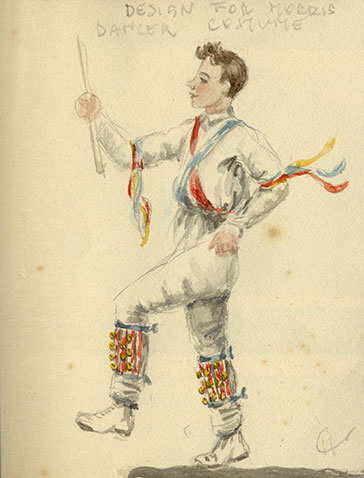
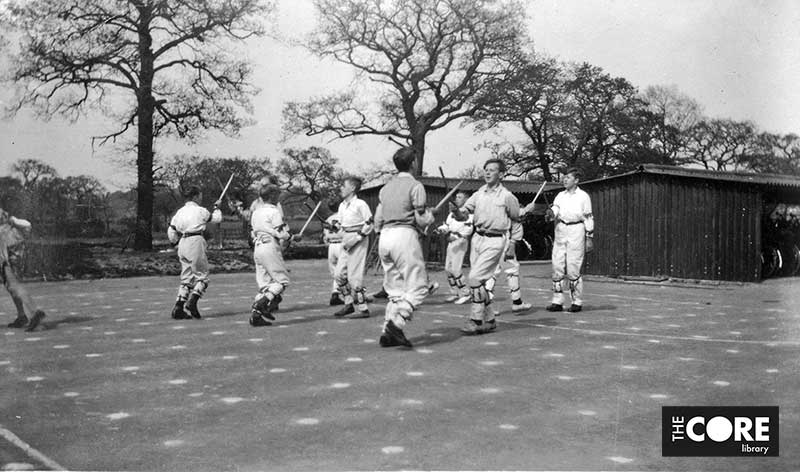
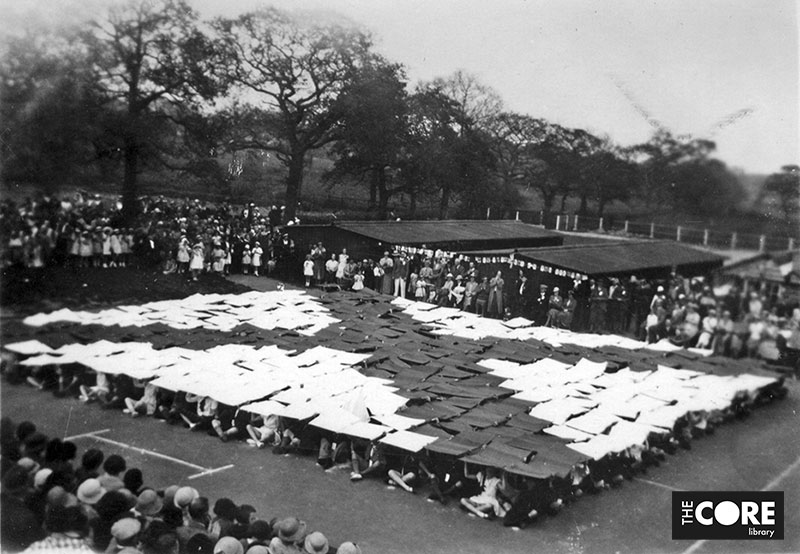
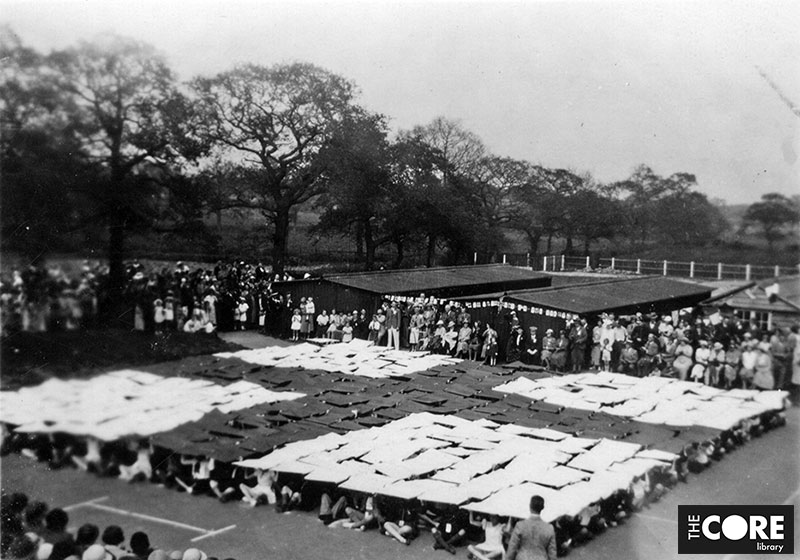
The flag ceremony stood out in people’s memories for many years. Pupils sat down in neat rows in the playground and, at a given whistle signal, they held stretched above their heads an appropriately coloured square of cloth, changing in turn to form the flags of England, Scotland, Ireland and Wales and, as a grand finale, the Union Flag.
Separation into Boys’ and Girls’ Schools
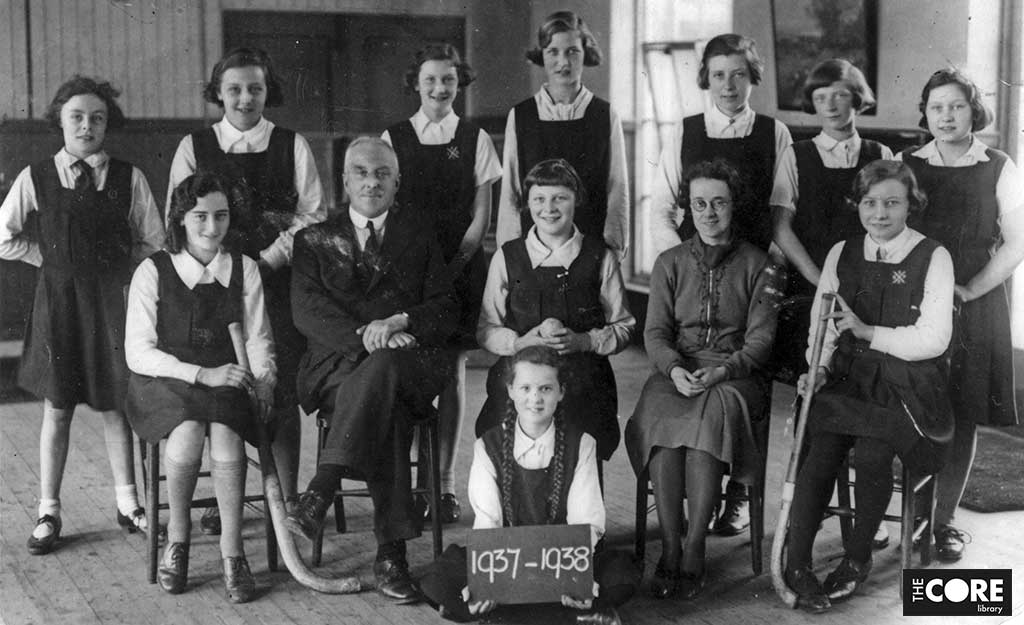
In 1938 the growth in pupil numbers led to the division of the school into separate boys’ and girls’ schools, each with their own headteacher.
The original badge of Sharmans Cross Senior School, Solihull was retained by both departments. It consisted of four white “S” initials within the arms of a white St Andrew’s Cross on a blue background.
The highest honour the school could award was the Walker Shield to the girl who was “all that a girl should be through her school career,” and the Featherstone Shield to the boy “who in the opinion of his fellows had, during the previous year, set the highest example of true manliness.”
Second World War
On 4th September 1939, staff reported for duty but the children were sent home for the week. A week later, the children returned but, after having their gas masks fitted and inspected, they were again sent home as no air-raid shelters were available.
There was no schooling until 20th September 1939 but the school operated on a shift system – for a week, the girls attended school in the morning, and the boys in the afternoon. The following week, the pattern was reversed. It wasn’t until January 1940 that the school re-opened full-time.
Brick and concrete air-raid shelters were built at the back of the school and if the air-raid siren sounded during school time, everyone marched down the playing fields to the shelters, with the girls on one side and the boys on the other. Songs were sung as loudly as possible until the “all-clear” was sounded.
On 27th August 1940, pupils were sent home as incendiary bombs fell on the school and playground during an air raid. During the Second World War a class of French evacuees and their teacher used the Science Room (which later became Childcare Room 12) as their classroom. One of the 12 houses built opposite the school was requisitioned by the Royal Air Force as a barrage balloon unit.
900 children from London were evacuated to Solihull in October 1940, and some attended Sharmans Cross School for a time until the Evacuees’ School was opened in Solihull.
“Maggie”
The playing fields at Sharmans Cross School became home to a barrage balloon, named Maggie (or Aggie). At first, the balloon was attended by boys from the Royal Air Force, but they were soon replaced by a group of females from the Women’s Auxiliary Air Force (WAAF).
When it was calm, Maggie behaved herself but was described as becoming a demon during high winds and almost unmanageable. The WAAFs were sometimes pulled off the ground and often suffered from blistered hands despite wearing gloves.
One night, Maggie broke loose and terrified local people by dragging the mooring chains over roofs and gardens. A man in Radbourne Road reportedly thought the end had come when he peeped out of his Anderson shelter and saw a monster!
The balloon seemed to attract lightning and twice came down in flames. Girls playing netball had to flee inside the school to avoid being hit by the heavy cable.
Despite all this, people said that it was comforting to see Maggie floating protectively above the school.
Sometimes, the air-raid warning would sound before the end of school and then everyone had to make for the shelters. Each class knew exactly what to do and which shelter to go to. Their teachers took the class registers with them to check that no one had been left behind. Nobody was allowed to leave the shelter until the All Clear sounded. Once or twice they had to wait for hours and the mothers in the houses opposite took pity on them and very kindly and bravely ferried tea and sandwiches across the field.
On moonlit nights it was much easier for the enemy to find targets so smoke screens would be lit to obscure potential targets. Bins of crude oil were placed on the edge of the pavement outside the school and all along the roadsides in a line east to west across Shirley. Every night before blackout, teams of men went around with bags of cotton waste. A small bundle was set alight and put in the bins. As the oil burned it sent up an evil-smelling oily fog.
People shut all their windows as the smoke screen covered everything with a horrible greasy black film. The prevailing wind being south-west, it was hoped that the artificial fog would be blown over Birmingham and the task of the raiders made more difficult.
Miss Dora Jones, head of the Girls’ School, organised her staff into fire-watching teams. The teachers took it in turns to patrol in between having a nap or snack.
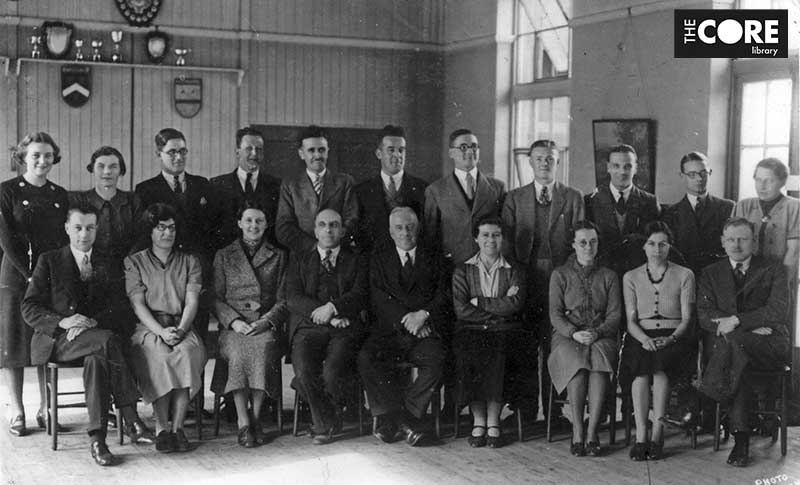
back (l-r): ?, ?, Mr Jackson, Mr Guest, Mr J. B. Coe, ? Mr Jackson, ?, Mr Reginald Taylor, ?, Mr Thomson, Miss Elizabeth Spensley;
front (l-r): ?,?, Miss Mackenzie, Mr G. F. Peppitt, Mr Orrett, Mrs Jones, Miss Whitworth, Miss Ross, Mr Lloyd
August 1943
During August 1943, the schools were kept open for those pupils whose mothers were engaged on war work. The hours of attendance were from 9.30am-3.30pm with staff sharing duties between them for the month. During the first week, games occupied the mornings and plays or singing the afternoons. On Friday the girls cooked dinner for the boys, making 12 pies which the boys apparently thoroughly enjoyed.
The second week was very wet so the mornings were occupied with games in the hall and competitions for small prized brought in from home. Afternoons were spent on “Dramatics.” As the weather had cleared up on Thursday, the pupils went for a walk to Bentley Heath, picking nuts along the lanes.
During the third week, the pupils went to Dudley Zoo, taking their dinner with them. They also went to the pictures twice.
Part of the fourth week was spent dressing dolls, with girls bringing in material and making a series of different costumes. There were also treasure hunts around the school and field.
Art and music teacher, Miss Margaret Louise MacKenzie (1910-2015) worked with Girls’ School Form IIIa in 1942 to make “housewifes” for the Royal Navy. These were cases containing cottons, needles and darning wools to help sailors mend their own clothing. Where possible, a packet of cigarettes was also enclosed. The school magazine 1942 included letters of appreciation sent to the school in response.
Sharmans Cross Secondary Modern School
Following the 1944 Education Act, which was implemented in 1947, the senior school became Sharmans Cross Secondary Modern School (also referred to as Sharmans Cross County Modern School), catering for pupils who had not passed the 11-plus examination to attend grammar school. Mr Orrett, headmaster, left Sharmans Cross in 1947.
A new badge was adopted by both the Girls’ and Boys’ schools in 1947. The badge depicted a sword held with the hilt upwards as it would have been held by men taking their oaths of knighthood. The badge was described as standing for chivalry, courage and unselfishness and deriving from the name “sharman/ sherman/ shearman” originating from the old English ‘sceran’ to cut, found in the word shear and ploughshare.
The school motto – “Nisi Dominus” was introduced at the same time. This was a shortened form of a line from Psalm 127 -“Unless the Lord builds the house, those who build it labour in vain,” said at the time to mean for the school that however fine outwardly a school may be, it’s a sham unless the spirit of the school is right.
Instead of leaving school aged 15, some of the boys in 1954/55 stayed on at school for an extra year in order to take the same G.C.E. exam that they would have taken if they had passed their 11-plus examination and attended a grammar school. All reportedly passed.
Radbourne Road Site
To ease overcrowding in the school, which was built for 700 but had 1,300 pupils, a new Boys’ School was opened on Radbourne Road in September 1957 and the Girls’ School took over the whole of the existing Solihull Road site.
It was described as “the most up-to-date school of its kind in the area” and replaced the two annexe sites that had housed the boys during 1953-56 – the British Restaurant and the Community Centre in Gilliver Road.
Comprehensive education
With the introduction of comprehensive education in Solihull in September 1974, the boys’ and girls’ schools merged again to form a co-educational establishment. Sharmans Cross School, Shirley was formed from the merger of Sharmans Cross High School for Boys, Radbourne Road, and Sharmans Cross High School for Girls, Solihull Road. There were 1,376 pupils on the roll.
The former girls’ school became the Lower School for 1st, 2nd and 3rd Year pupils, and all year groups also used the domestic science, art and music facilities on the site. The Radbourne Road site of the former boys’ school accommodated the Upper School pupils as well as all year groups using craft subjects.
The headmaster of the boys’ school, Mr A. S. York, was offered a full-time appointment as co-ordinator to the Council’s Advisory Board on Secondary Education. The headmistress of the girls’ school, Mrs Beales, became the headteacher of the new comprehensive school.
The old House system, which had been in place for 40 years was disbanded, and the school was organised on a horizontal year system.
The Sharmanians Club
On 19th December 1972, a reunion was held for ex-pupils of Sharmans Cross School 1934-39. Attendees included former teacher, Miss Elizabeth Spensley, who was still teaching at Sharmans Cross Girls’ School after 38 years! A follow-up meeting in February 1973 resolved to form a club, known as the Sharmanians, for ex-pupils who attended the school 1934-1959. Mr Basil George was elected Chairman and an inaugural cheese and wine party was held on 23rd March 1973. Regular events were held until 1979.
Closure announcement
Falling pupil numbers in primary schools were noticed in the mid-1970s as being a cause for concern, and the problem would affect secondary schools in the early 1980s. At Sharmans Cross, the school year began in 1976 with 986 pupils on the roll, a decrease of 400 in four years.
Similar decreases were experienced in other schools, meaning that Solihull had an excess of secondary school places. In 1981, the Education Committee said that 5,000 surplus places had to be cut by 1986. In October 1981, three secondary schools were earmarked for closure – Kingshurst Comprehensive (which was sold to the Government for the first City Technology College) plus two schools out of Lode Heath, Malvern Hall and Sharmans Cross.
An action committee was formed to fight the closure of Sharmans Cross, with parents saying that the school had an excellent academic record, a high standard of discipline and a dedicated staff. However, the decision was taken in March 1982 that Sharmans Cross and Malvern Hall would close.
The headmistress of Sharmans Cross – Mrs Cecile Beales (1924-2005) – immediately announced her retirement. She had taken over as headmistress of Sharmans Cross Girls’ School on 7th September 1965 and had then become the Headteacher of the new comprehensive school in 1974. She retired in July 1982 and was replaced by Mr Peter G. McLauchlan (1931-2022), who took over as Headteacher for the final few years of the school.
The final date for any normal admissions to Sharmans Cross was 31st August 1983. No more children were admitted after this date apart from individuals who had moved into the area. From this date, the number of pupils and staff would decrease rapidly at the end of each year.
Golden Jubilee 1984
A celebration of the school’s Golden Jubilee was held in 1984 with slide shows, talks and displays of photographs. A 1930s day was held, with teaching as performed 50 years previously, and there was also a 1930s Sports Day.
“Showstoppers” musical evenings were held on 11th July and 13th July with excepts from previous school productions. On 12th July the school band – the Sharmanaires – performed.
In 1983, it was suggested that one or both of the Sharmans Cross School sites could be offered to the Church of England, which had been asking for several years to have an Anglican secondary school near Solihull town centre. Parents of children attending St Alphege Junior and Infant Schools started an initial campaign and were supported by parents from across the Borough. With 13 CofE primary schools across the Borough, parents questioned why there were two Catholic secondary schools in the Borough, but no Anglican equivalent.
The plan was rejected by Solihull Education Committee in June 1987, on the basis that the school being on two sites made it unsuitable and the buildings would require expensive repairs. It would also mean that another comprehensive school with better premises would have to be closed instead. The Committee was also told that the Birmingham CofE Diocesan Education Council had also ruled out Sharmans Cross as an option for a voluntary aided school.
Solihull Ratepayers Association requested that the Lower School site be turned into a park. Another option considered was for the site to be offered for lease as a leisure centre. However, with no buyers or local associations coming forwards to take on the site for educational or sports use, the Council decided in July 1987 to apply for planning permission for low-density housing on the Solihull Road site, meaning that it could be marketed for housing.
Final closure
Sharmans Cross School closed in August 1988, with pupils during the final year numbering 76 and with a staff of 11. The final pupils left the school after completing the GCSE examinations in June 1988. A party was held and the children were taken on a trip to Alton Towers. Other celebrations included a musical evening at the Solihull Library Theatre, a Supper Buffet at the school, and a display of photographs and memorabilia.
The few remaining staff left the premises for the final time on 26th July 1988.
Sale and conversion
The Lower School site at Solihull Road was sold for housing. The sale of the 8.61-acre site was originally expected to bring in around £2m to the Council but it was sold to Wimpey Homes Ltd, the highest bidder, whose offer of £4,268,000 was accepted by Solihull Council in January 1989.
It was decided that the Upper School site would be used to ease overcrowding at the main Blossomfield campus of Solihull College of Technology, which had been having an increasing involvement in the use of the school buildings as pupil numbers at Sharmans Cross continued to fall. By 1988, the college students occupied 10 rooms in the Upper School and shared the cafeteria facilities.
The premises were converted into Sharmans Cross Campus of Solihull College of Technology, which opened in January 1990 and provided an additional 722 places for college students. The grounds of the former Upper School were retained as public open space.
If you have any further information about Sharmans Cross Secondary School, please let us know.
Tracey
Library Specialist: Heritage & Local Studies
© Solihull Council, 2024.
You are welcome to link to this article, but if you wish to reproduce more than a short extract, please email: heritage@solihull.gov.uk
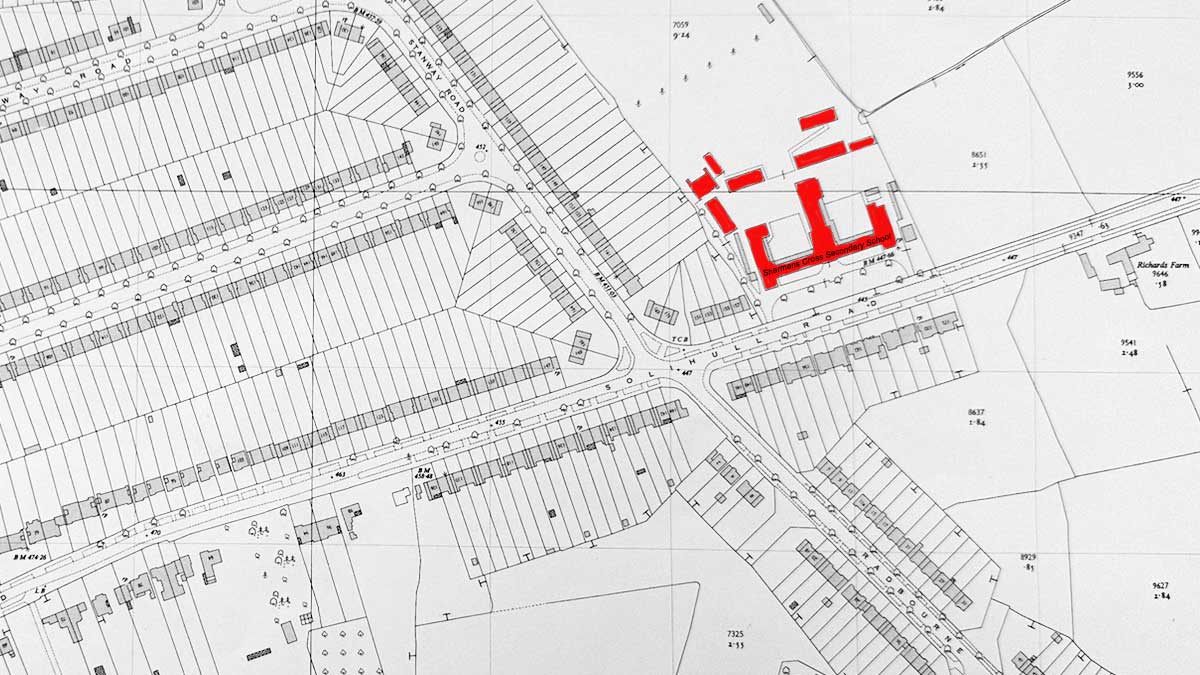
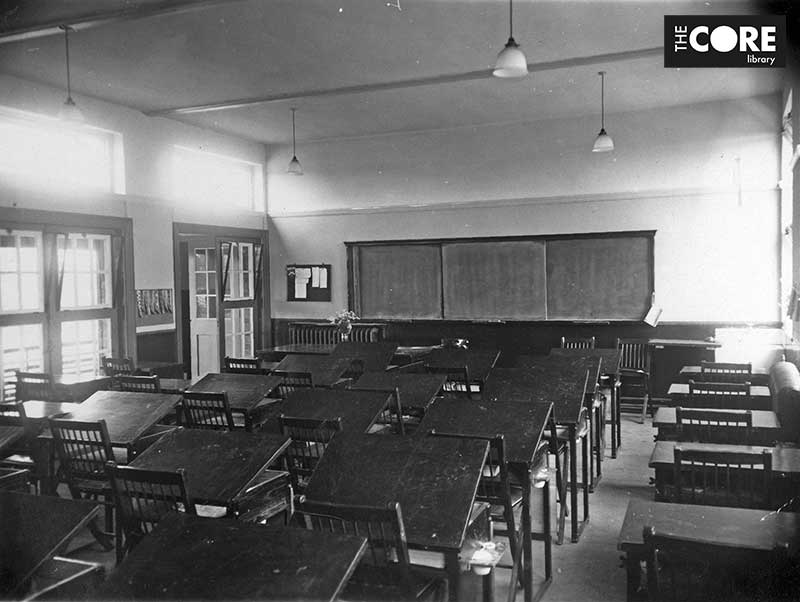

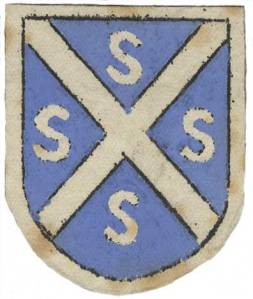
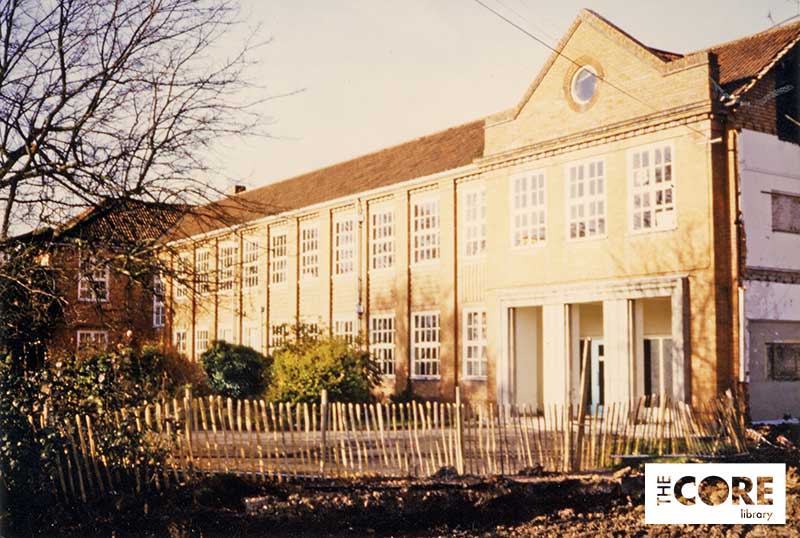
Thank you so much for such a splendid history of Sherman’s Cross. I am now 85 and was a pupil there from 1951/55 under the headship of Mr Hodgeson who went on I believe to Rugby school. I remember very well Mr Baynes deputy head and taught science. Also I remember Mr Adams RE teacher who kept his cane in a tube of olive oil. Age now restricts my memory but they were happy days and the cane certainly did me no harm.